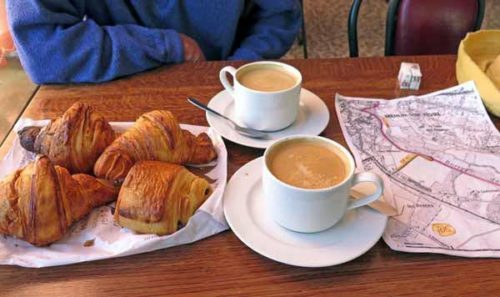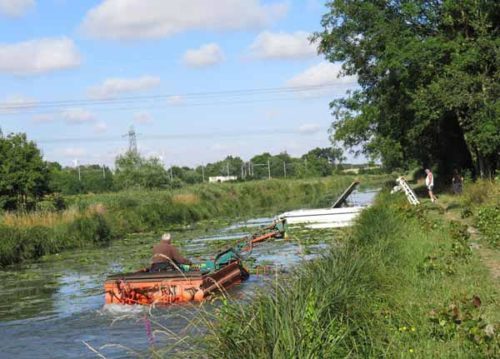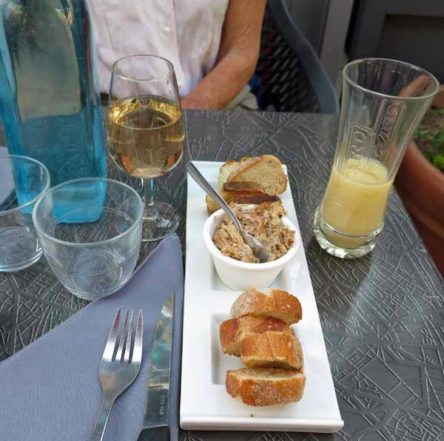Thursday, 9 July 2015
Distance 20 km
Duration 4 hours 15 minutes
Ascent 3 m, descent 6 m
Map 134 of the
When we woke up, a cold wind was streaming through the camping ground and we were full of doubts.
Keith was still worried about his leg and also about the long slog from Bourges to Dun-sur-Auron. I was worried about having nowhere to stay the following night.
We almost decided to call a halt to our walk there and then, take the train to Bourges, then go on to Paris for a few days before catching the plane home. But in the end it seemed a better idea to walk the short distance to Bourges and think again after that.
So we got up and swung into action. Pausing at the boulangerie for a bag of croissants, we went through the Porte de l’Horloge and ambled down to the Bar de France on the canal.
It was warm and pleasant inside, out of the cutting wind, and we had two pastries each with our coffee. They were beautifully fresh, just out of the oven, but we found that we could hardly fit them in – our insides must have shrunk over the past few weeks.
We were in no hurry, as it was a short day’s walk and the weather was cool, but at about eight o’clock we set off along the towpath.
Although the Canal de Berry is declassified and no longer used by pleasure boats, it is nevertheless very pretty.
Our first steps was beside the lower gardens of the Château of Mehun, now a public park with lawns, seats, lakes and little bridges over the Yèvre.
One of the round towers of the castle could be seen through the treetops.
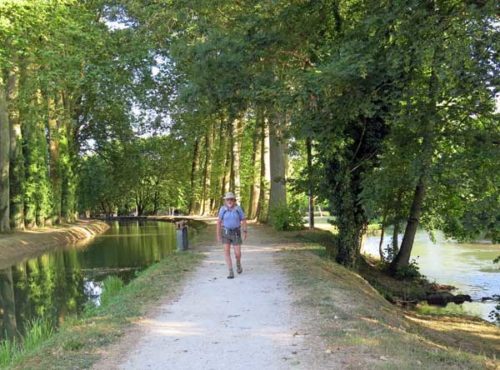
Further on we came to open countryside. At first the canal was flanked by the characteristic formal double row of trees, but eventually they gave way to scrappy bushes.
The water in the canal was choked with weeds and some workmen in little barges were scooping out masses of vegetation onto the bank.
None of this impeded our progress and after about eight kilometres we came to a road bridge at the village of Marmagne, where a modest château stood mirrored in the canal. It was

We crossed over hopefully and found a bar at the first corner. It was an old-fashioned tabac – a newsagency, betting shop and café rolled into one.
We sat outside at small iron table, looking over at the handsome but unremarkable church.

To get back on the canal we crossed a footbridge behind the bar. The wheel track that we had been on till then was now a narrow white path, but it was easy walking. Our only worry was that it would suddenly stop or disappear into a mass of brambles, but it didn’t.
After going under the high bridge of the D400, we crossed the canal and entered the outskirts of Bourges. Once again the canal was framed by regularly spaced overarching trees and there were several bridges. Across the water we could see shops, parking areas, traffic and all the bustling life of the city.

Then the water in the canal abruptly stopped, but its line, including the rows of trees, carried on over a stretch of parkland.
Halfway along it was intersected by a road bridge and this was where we turned off, as the camping ground was only a couple of hundred metres up this road.
The reception was unoccupied as we entered so we walked in, only to be accosted by the manager on his way back to the office.
So we went back with him and filled in many forms, one of them asking whether we were pilgrims. We said we were, hoping for a discount or even a free night, but no such concession was forthcoming.
The place was crowded, not surprising in a big city, but our pitch had good grass and adequate shade which was all we needed. After our ablutions and a short rest, we climbed to the centre of town, which was on a high spur of land between the river Yèvre and its tributary, the Auron. Naturally all signs pointed towards the cathedral, but for the moment we were more interested in the Office of Tourism, which was next to it. We had questions to ask.
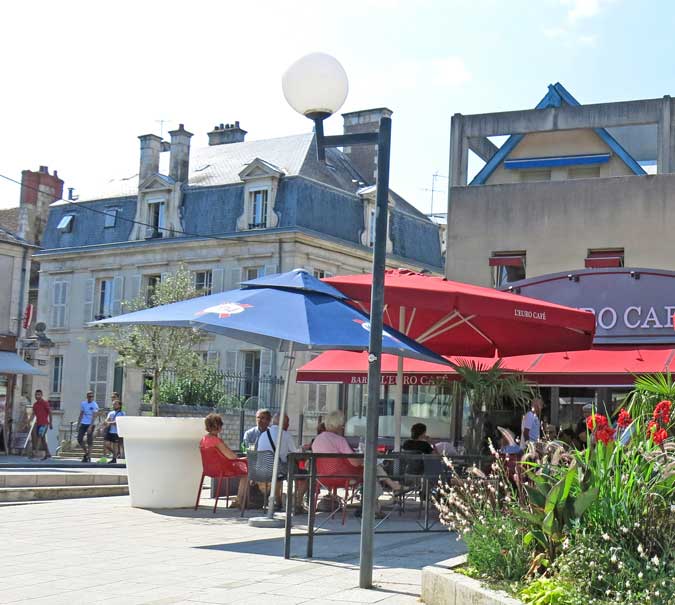
We were hoping to camp at a farm near Bannegon in two days’ time. If we could not confirm the existence of this camping ground, we would need to decide whether to finish our walk here, or to go on to Dun-sur-Auron and then either trudge down the D10 directly to St-Amand-Montrond, or continue to the junction of the two branches of the canal and find somewhere to stay beyond that.
The woman at the Office of Tourism assured us that there was no camping at Bannegon and it was only when Keith showed her our map with the camping symbol that she did an internet search and found it. There was a telephone number, which she kindly rang, but nobody answered, so she said that we should come back later.
We retired to a nearby brasserie and sat under a scarlet umbrella for a round of beer, then had a look at the cathedral.
Although it is now jammed in amongst vulgar buildings, it remains a breathtaking sight, with its great pyramidal bulk held in place by flying buttresses and its five western portals, each one leading to a nave.

It was one of the first wave of French Gothic cathedrals built in the twelfth and early thirteenth centuries, at the same time as Chartres and Notre Dame de Paris.
Like all these churches, it stands on the remains of earlier edifices going back to Gallo Roman times or even earlier.
The crypt at Bourges was interesting to us, as it contained the tomb of Jean de Berry, who had remodelled the Château de Mehun and included it in his book of hours, les Très Riches Heures du Duc de Berry.
At a boulangerie we bought four great slabs of quiche for the long march tomorrow. After that we returned to the Office of Tourism, although our hope was fading.
The helpful woman tried the phone number of the farm again with the same lack of success, but then she noticed a mobile number and that produced a result. The woman who answered said everything was fine, she would expect us on Saturday, and would even provide a cold evening meal.
Suddenly all our worries were over. We shook the hand of our beaming saviour and went off to celebrate at the brasserie. We were now confident that we could get to our final destination, St-Amand-Montrond, in three more days, as we had planned.
For aperitifs we had our usual pastis and rosé, but the rosé, which was from Reuilly, a few miles away, took the prize for the palest ever, in this land of pale rosés.
It was delicious of course, and the drinks came with a mise-en-bouche of bread and rillettes.
The dinner proper began with a shared plate of crudités – all the summer favourites such as beetroot, grated carrot, tomatoes, green beans, and red onion. This was a good start.


After that we hit the protein. I had onglet with eschallots and fennel, while Keith had the full mixed grill – steak, pork, sausages and a even section of andouillette, his most loathed and feared food.
However with blue cheese sauce and a large baked potato on the side, he managed to enjoy all of it. The red wine was splendid and we emptied two baskets of bread.
When we got back down the hill to the camping ground, every spot seemed to be taken and we were glad that we already had a place.
Previous section: Gien to Mehun-sur-Yèvre

